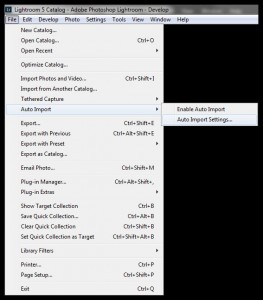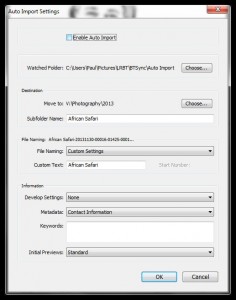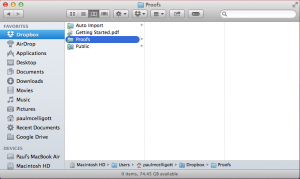Imagine you’re a photographer. Okay, that was probably the easy part.
Let’s say you’re going on a long vacation and bringing your trusty DSLR, a couple of your favorite lenses, and a pocket full of memory cards.
Two things are relatively certain. One is that you are not going to stop to edit your photos in Lightroom in the middle of your vacation, especially not if you are traveling with family. The second certainty is that you’re to going to return from said vacation bone-tired and, after unpacking, the thought of going through several hundred RAW files will terrify you, and your vacation photos will sit, unprocessed and unseen, for days, their existence clawing at you until, wracked by guilt, you finally sit down and start feeding your cards into the computer.
I can’t promise to eliminate the problem, entirely. The prospect of scouring through multiple gigabyte worth of photos will still be daunting, and you will still be bone-tired upon your return from a long holiday, but I can at least offer a solution that mean all your photos will be waiting for you, already imported into Lightroom, and ready for the sorting and editing.
This system does assume a few things on your part.
One, you have both a laptop and a desktop computer.
Two, you use Adobe Lightroom.
Three, the desktop computer can be left on, with Lightroom running, while you are away.
Four, you subscribe to one of the various cloud storage services that are available, such as Dropbox, SkyDrive, Google Drive, or Copy.
Setting Things Up Before You Leave
There is a little setup before you actually leave on your vacation.
The first step is to sign up for one of the cloud storage services. For the uninitiated, these services take every file you put into a folder and copy them to their web servers (securely and privately). If you have the service installed on more than one computer, the files are duplicated and synchronized on each computer. If you make a change to one copy, the new version is copied to the web and the other computers.
We’ll talk about the relative merits of the different services below.
The second step is to set up Auto Import in Lightroom.
Auto Import watches a folder on your computers. Any image files in that folder are automatically imported into Lightroom using the settings you select.
Click the File menu, then click Auto Import, and select Auto Import Settings…
Let’s pretend that I’m going on an African safari (don’t I wish). For my watched folder, I’ve selected the “Auto Import” folder that I put in my cloud service folder. For my destination, I selected the “African Safari” folder under my main “2013” folder.
What this means is that, when an image appears in the Auto Import folder, Lightroom will automatically import it into the catalog and move the file into the African Safari folder.
You can also select file renaming settings, if you like, as well as metadata and develop presets. I wouldn’t normally set up develop presets for pictures I haven’t taken, but you might want to set up a preset to enable Lens Profile and Chromatic Aberration corrections.
So, now you leave Lightroom running, pack your backs and head out on vacation.
While You’re On Vacation…
As you wander the globe, snapping gigabytes of stunning, award-winning photos, you stop at the end of the day, hopefully in some place that has some form of adequate internet access. That is the big variable in this workflow. Depending on where you go in the world, the internet goes from part of your everyday life to an unimaginable luxury. If you are on a cruise ship, the phrase “shit out of luck” accurately describes the internet situation.
You may have to wait until you can get to a hotel, an internet cafe, or even the airport. And when you depend upon public internet access, you need to take care when in comes to security. I highly recommend a VPN service like proXPN to keep your internet traffic away from prying eyes.
Okay, assuming you have a few minutes of access to adequate bandwidth. Take your memory cards and copy them into the auto import folder under your cloud service. Immediately, the cloud service began uploading your image files to their servers and also downloading them to your computer at home.
As I describe above, Lightroom immediate begins vacuuming up the new images, importing them into the catalog. As a result, the files disappear from the cloud service and from your laptop. Repeat as necessary.
When you get home from your vacation, all of your RAW files are waiting obediently in Lightroom, with the first, most drudgerous part of the job already done.
You didn’t have to worry about something happening to your photos because you lost a card or because you lost control of your laptop while passing through customs or airport security.
But What If I’m Not Going on Vacation?
As I was writing this, it occurred to me that it might have other applications in other situations.
Imagine, if you can, that you are a commercial photographer, such as a wedding photographer or anyone who works on location.
You also need to imagine that you are successful enough to have at least one spare assistant waiting back at the office, able to help with the initial post-processing. You might normally have that assistant with you, working on a laptop, but let’s say you’re on the road and don’t have the travel budget to bring your assistant along.
Whatever the reason, the workflow could be like this:
During a break from shooting, take fifteen seconds to stick your memory card into your card reader, copy them into the cloud service folder. The cloud service uploads the files and downloads them to the computer back at the officer, where Lightroom imports them.
At that point, your assistant starts doing preliminary edits in Lightroom, and then exporting jpeg proofs to another folder under your cloud service. Let’s call it Proofs.
Even before you’ve finished shooting, you have polished preliminary images to show your client.
Cloud Options
Each one of the cloud services gives you a small amount of storage for free. Dropbox gives you a miserly two gigabytes and Skydrive gives you seven. Google Drive gives you fifteen, but you share it with your email and photos if you also use those Google services. Copy.com, a lesser known competitor, also gives you fifteen and makes it easy to bump it up to more than twenty.
Because Lightroom is not keeping your image files in the cloud service folder, you probably don’t need more than that. Files are being deleted as fast as their being downloaded to your home computer.
Of course, this means that there are no backup copies on the cloud, but you’re backing up your image files already, right?
You can also use BitTorrent Sync, a free, open-source service that synchronizes files between two computers without a stop in the cloud.
Again, this approach works only under certain conditions, but it does automate some of the least interesting parts of photography.




